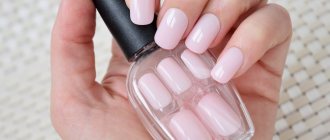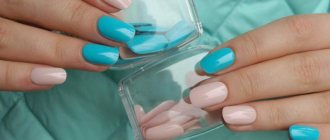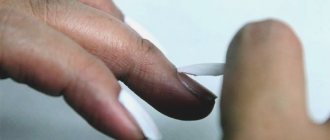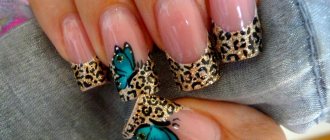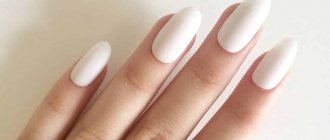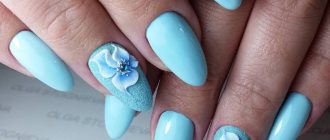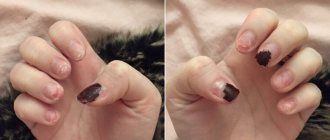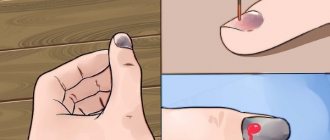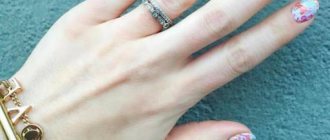Little girls notice beautiful things quickly, especially if it comes from their mother. Little ones will definitely want to recreate well-groomed hands, and even with an attractive, bright manicure with a pattern, on their still fragile fingers. What can you offer to little fashionistas 5-6 years old and girls under 14 years old, so as not to harm their health and fulfill their desire? One of the best options for getting out of a situation with two unknowns is false nails for children.
False nails for girls
Nail care for children and teenagers
The technique of performing children's manicure and design is completely different for five-year-old children and teenagers 12-14 years old. To carry it out correctly without causing injury, you should know that up to the age of 15, the formation of the matrix occurs - the zone in which the nail plate is formed.
This area is located next to the cuticle, so it is not recommended to use tools to remove it, as in a classic manicure for adults. Up to 8 years, the cuticle is simply slightly moved with a soft stick, if necessary. For 8-10 year old girls, soft, gentle treatment with preparations such as a dissolving agent or hand balm is allowed. Cuticles cannot be cut with scissors or removed with any abrasive materials.
At home, without proper experience, you should not manipulate in children's manicure, so as not to cause serious injury to the matrix. Teenagers 12-14 years old are allowed a more intense effect during manicure, if the thickness of the skin and the location of small vessels near the nail plate allow. Professionals in spa salons use non-abrasive tools when performing children's manicures.
Technology of unedged children's manicure
- You should remember the main rule of manicure: do not start working on your nails without disinfecting your child’s hands. This will prevent the possibility of contracting a fungal infection. Any antiseptic in the form of a gel, spray, or wipe will cope with this task.
- Next, select a nail file to process your nails. The best option for thin nails of girls would be ceramic and glass, which have a degree of abrasiveness in the range of 220-320 grit. Ceramic - has the property of sealing the processed edges of the nail; both materials do not allow the nail plates to delaminate.
- File the open edges of the nails, leaving at least 1 mm in length.
- Get rid of cuticles using a remover cream. Apply it in a thin layer, then use an orange stick to gently push back the cuticle.
- Use rounded scissors to remove existing burrs.
- If a little fashionista still allows herself to bite her nails, then she should use a special anti-biting coating. This will allow the polish to last longer after application.
- The penultimate step is varnish coating, for which it is better to use gentle bio-varnishes for children.
- The finishing touch will be the application of care oil to protect the baby's delicate hands and nails. It can be used from the age of 4 years.
Fake nails
Important! When a child gets a small cut while doing a manicure and there is bleeding, the area is treated with hydrogen peroxide and a bandage is applied. If an abscess occurs on the nail, apply levomekol and make a bandage. If you do not trim your nails properly, the nail may become ingrown into the skin.
In this case, baths with furatsilin (1 tablet/cup of water) will help. If your nail is deeply ingrown, you should definitely visit a doctor. It is better to push back the cuticle after a preliminary warm bath, when the skin has steamed and is easily affected. Then there is less chance of burrs occurring. Gradually, the child will gain nail care skills and learn to use a file and scissors.
Safe plastic nails for children
For girls, you should purchase only high-quality pads from well-known brands, designed specifically for children. Poor quality material can cause allergic reactions in a child.
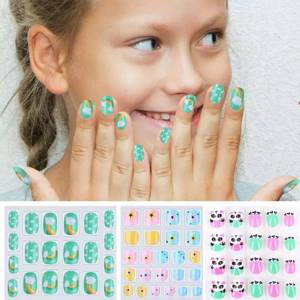
For girls under 15 years of age, you should purchase only high-quality false nails from well-known brands, designed specifically for children
Well-known manufacturing companies make children's tips from high-quality plastic with rounded edges that do not damage the child's skin during play.
Manufacturers and prices
The table shows the manufacturers of children's plastic nails:
| Manufacturer | Cost, rub.) |
| Broadway (Kiss series) | 336 |
| Lovely | 360 |
| Donegal | 315 |
Criterias of choice
You can purchase tips in professional salons or order them online.
When choosing, you should follow the recommendations:
- Self-adhesive, flexible plates are cheaper and more convenient to use. They are perfect to give a girl's nails a beautiful look for hours.
- More often, plates are sold with a colored coating and a certain size. When purchasing, you should study the parameters so that real nails and tips do not differ in size.
- When choosing nail plates, you need to carefully read the composition so that the description indicates that the tips are made of plastic for cosmetic purposes.
- Children's plastic plates should have soft edges so that the child does not accidentally injure the pad on his fingers.
When choosing glue, you need to pay attention to the composition, choosing the most natural and safe one so that it does not cause allergies in the child.
Preparing nails for applying false nails to children
Before you stick on the yews, you need to get your nails in order. You cannot use the classic technique of preparing for a manicure as with adults, since before the age of 15, the process of matrix formation occurs - this is the zone in which the nail plate is formed.
It is allowed to use gentle treatment with dissolution preparations and balm with vitamins for hands. Girls over 10 years old are prohibited from removing cuticles.
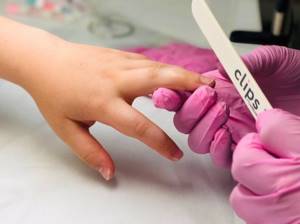
Before applying false nails, you need to disinfect your child’s hands. Proper preparation will prevent the possibility of fungal infections. Antiseptic gel, spray or wipes are suitable for treatment.
After disinfection, you need to treat the nail plates:
- Choose a ceramic or glass file with a degree of abrasiveness from 220 to 320 grit. The ceramic surface seals the treated edge and prevents the nails from peeling.
- File the open edge of the nail, leaving no less than 1 mm in length.
- Apply a thin layer of remover cream to the cuticle, then use an orange stick to gently push back the cuticle.
- Remove hangnails with rounded scissors.
- Wipe the surface of the nail with a disinfectant.

When gluing tips, you should remember that long nails are unsafe for a child, so you should first file the false nails to the desired size.
If, while preparing nails, a child gets a small cut and bleeds, the damaged part of the skin should be treated with hydrogen peroxide and a bandage applied.
How and how to glue tips, step-by-step guide
To make false nails flexible, you can dip them in boiling water for 3-5 minutes. This preparation will allow you to press them as tightly as possible to the nail and glue them securely.
If children's tips come with glue, then you need:
- Select the overlay plates according to size and arrange them in a convenient order on the table so as not to confuse the sizes during the gluing process.
- If there is a grip at the tips of the false nails, then it is broken off and filed, removing all the irregularities.
- Degrease the surface of the nail with a special product.
- Drop a little glue onto the pad and spread it in a thin layer. There is no need to apply the product to the free edge, where the plate will not come into contact with the natural one.
- Place the tips on the nail and press slightly, holding for 15 seconds.
Remove any remaining glue with a wooden stick or napkin. If necessary, adjust the length of false nails.
How long can children wear false nails?
Children's delicate skin is often susceptible to allergens, so you should not allow your child to wear pads for a long time:
- With frequent and prolonged use of tips in the nail plates, blood flow is disrupted, which causes problems with manicure in the future.
- While playing, a child may accidentally twist a nail and break it.
- The plastic plate and the nail are tightly fastened together with glue. If the top layer is damaged, a moist environment is formed in the layer between the artificial and natural nail, which contributes to the development of infection. With long-term use of tips, the problem is not noticeable. As a result, the girl may develop fungus.
- When worn for a long time, the pads dry out the natural plates, making them thin and brittle. Glue can provoke allergies, leading to inflammation of the nail bed.
It is recommended that girls use the tips for several hours, sticking them on during a children's party.
How to remove tips
The overlays must not be torn off, otherwise the nail plate will be injured . To remove tips, use a warm bath. Under the influence of water, the glue quickly dissolves, and the plastic plates easily come off the nail.

To remove tips from a child’s fingers, you need to:
- Immerse your hands in warm water for a quarter of an hour. If the tips have not come off, then drip nail polish remover under the top of the artificial nail.
- Carefully, without making sudden movements, pry the plastic plate off the cuticle and separate it from the natural nail.
- Remove any remaining adhesive with nail polish remover.
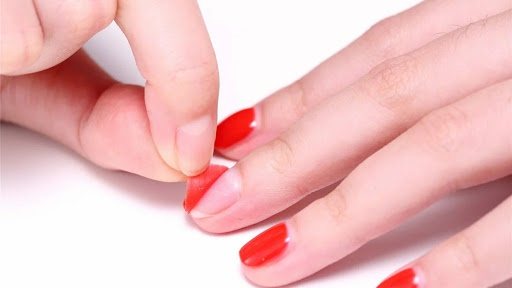
To restore and strengthen the child’s nail plate, you need to rub nourishing oil, which contains vitamin E and A, into the surface.
At what age are false nails acceptable?
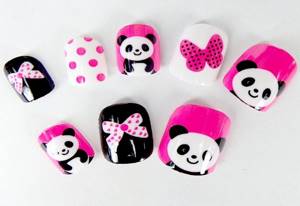
False nails for little ones
How to restore nails
The later a girl starts using nail polish, the better. It’s good if the mother controls the composition of the product that her daughter applies to her nails. Children's varnish should not contain formaldehyde and toluene.
False nails for children are a good alternative to polish, but they have their drawbacks. This is fashionable, you can choose them for any event: for the holidays, for the time of year, for your mood. They can be long, short, round or straight. But, in order not to harm the nail plate of children, it is better to wear them for a short time, not constantly.
The false nail and the natural nail are firmly attached to each other with glue. In case of damage to the upper artificial nail, a moist environment is formed in the layer between them, favorable for the development of infection. When wearing false nails for a long time, the infection is invisible, but can lead to serious consequences (fungus, etc.).
Artificial plates dry out natural ones, thinning them and making them brittle, which is not beneficial. In addition, gel and glue can cause an allergic reaction, which leads to various types of inflammation of the nail bed. The time when false nails will cause less harm comes at the age of 14-15 years.
Advice. Nails for girls 12 years old can be decorated with thrips of different types. Fortunately, there are entire sets on sale, complete with glue and false nails.
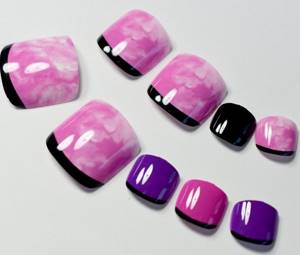
Thrips of different sizes
Step-by-step instructions with superglue
It is strictly not recommended to glue false nails with superglue. Firstly, this type of glue is quite toxic and can easily penetrate the body through open nail scales. Secondly, there have probably been cases in any person’s life when a small drop of super glue got on the skin of their hands. Was it easy to wash it off? Yes, it’s almost impossible, the glue comes off along with the skin. Now imagine how it is possible to remove nails glued to such glue? Most likely, only with your own nails.
But if the decision to glue your nails with superglue is made, you should adhere to the following rules:
- There is no need to degrease the native nail plate; this layer will serve as a “safety airbag”.
- You need to apply super glue to the underside of the false mold, and not to your own nail.
- When gluing, press the form against the nail for no longer than three seconds.
There are two ways to remove nails glued with superglue:
- soak your nails in hot water (temperature no less than 45 degrees) for about 20 minutes. The superglue should soften and come away from the live plate. Under no circumstances try to tear off the false nail by the long edge; to remove it, just pry it with something sharp near the cuticle area;
- using a special solvent. Do not use regular solvent as it will burn the skin. But nail glue solvent is quite suitable. It usually comes in the form of a varnish with a brush, which is convenient for applying the solvent, avoiding sensitive areas of the skin.
After removal, a medicinal product should be applied to the nails and the cuticle should be treated with oil.
How to make nails out of paper
Gel polish for short nails
When your child doesn’t have enough patience to wait until it’s safe to apply false nails, you can suggest that your daughter use white paper thrips. Making and decorating them will turn into a fun activity. The sequence is as follows:
- Measure the sizes of the nails and sequentially transfer them onto paper.
- The length is selected to be medium, slightly protruding beyond the nail plate.
- Marigolds are cut out of thick but soft paper.
- Girls apply colorless varnish or glue for false nails to the nail plates and attach paper blanks to it, holding each 15-20 seconds.
- Decorate your nails with a design.
You can get rid of paper thrips without difficulty and harm to the nail plates. Knowing how to make paper nails for girls, all that remains is to decide on a design for them.
European manicure
The safest type of manicure for children is called European. It is performed very simply and, most importantly, does not harm the child’s body and nails.
How to do it correctly?
To perform it correctly, you must follow the steps:
- First, hands are washed and disinfected, and all instruments are disinfected.
- A safe file gives your nails the desired shape.
- The hangnails are trimmed with pliers.
- If it is necessary to remove the cuticle, an emollient is first applied.
- Using an orange stick, the cuticle is pushed back, but without pressing on the nail itself.
- Hands are washed and the nail plates are lubricated with oil.
- Moisturizer is applied.
- If the nails need to be varnished, then this is done before using oil and cream.
- After creating the base, patterns are made, stickers and glitter are used.

Stages of nail extension for children 9-12 years old
In some cases, manicure specialists advise girls 10-12 years old to have their nails done with gel polish. The cause may be pain arising from improper nail growth (in the wrong direction) or a bad habit of biting nails. The extensions are done once for a month, after which they are cut down as they grow.
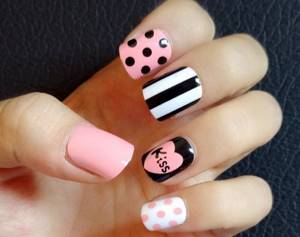
Nails for girls 12 years old
For the same reason, salons often recommend replacing false nails for children 10 years old with gel polish. This way the correct direction of growth of the nail and its surface is restored. It is important to give your nails a rest and take breaks when applying gel. In order to maintain the intervals between coverings, it is better to introduce them to holidays and significant events (March 8, summer, New Year, school).
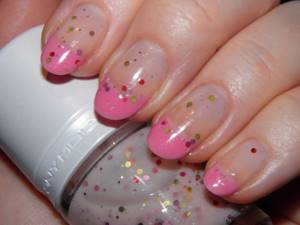
Nail extensions
The gel nail extension technique consists of stages that differ in duration and purpose:
- hand disinfection;
- cuticle removal;
- surface grinding;
- applying primer;
- applying gel polish with a brush (without touching the skin);
- lamp drying up to 2-3 times;
- applying the finishing layer;
- shape correction with a file;
- drawing.
Correctly performed gel extensions last 3-4 months. After which the child needs to take a break.
It is important to know! Only professional salon technicians can do nail extensions correctly.
Advice from experienced manicurists
Experienced manicurists will never advise children under 14-15 years of age to perform shellac nails or extensions for no apparent reason. They will always warn the child about the consequences of the procedure and offer an alternative option.
Professionals will use soft surface files. Experts advise preventing the appearance of burrs and regularly cutting them off with sharp scissors, followed by disinfection. It is recommended to only move the cuticle, but not cut it. When doing nail extensions, it is important to apply a base (base) under the gel, and at the end - apply hand and nail cream.
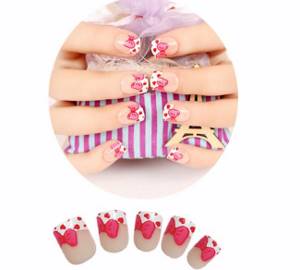
Thrips options
Beginning fashionistas are recommended to use stickers of different themes: stars, flowers, stripes. Each age has its own patterns on the nails. Extended nails for teenagers will be closer to the design of young girls. This is natural, because they are almost adults.
Girls, becoming familiar with hand care, take the first steps towards neatness and beauty. If they are interested in this, then parents have only one thing left to do: support the younger generation in their passion and guide them along the right path. The main thing is to contact competent specialists in salons.
Manicure for different ages
Each age has its own characteristics when applying manicure to nails. You should know this before starting work on creating the image.
Manicure at 7-10 years old
At this age, designs with cartoon characters, various colors, unusual fruits, many dots and stripes, simple patterns and cute animals with insects are more relevant for girls.
Great options:
- Delicate manicure of one color without decorations.
- A combination of animal images and lines with dots.
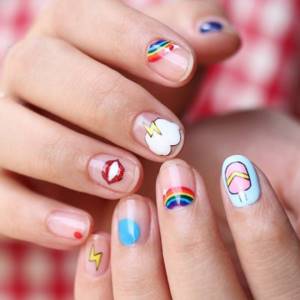
Manicure at 11-15 years old
Older age allows for more creative creativity.
The following can be applied to the nails:
- attributes associated with their hobby;
- romantic theme;
- stickers and emoticons.
Video

Coffee capsule Nescafe Dolce Gusto Cappuccino, 3 packs of 16 capsules
1305 ₽ More details

Coffee capsules Nescafe Dolce Gusto Cappuccino, 8 servings (16 capsules)
435 ₽ More details
Sounders
